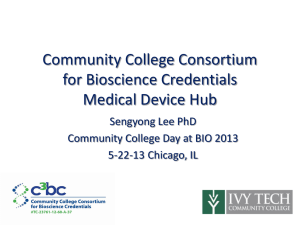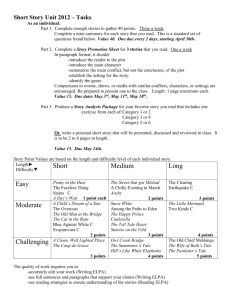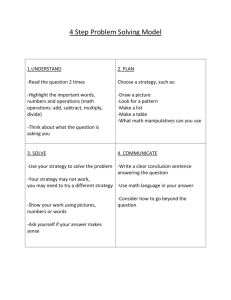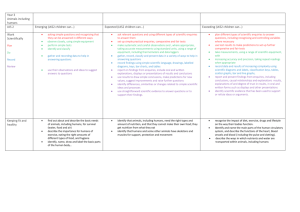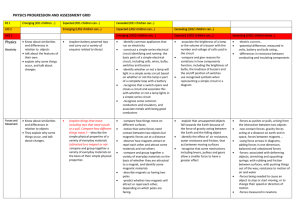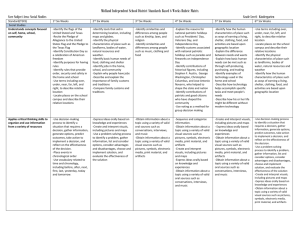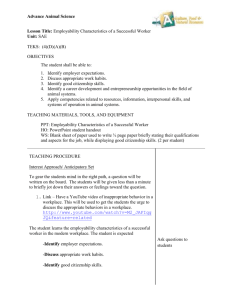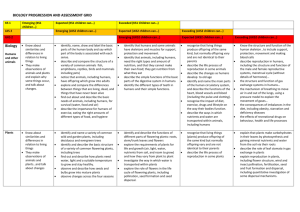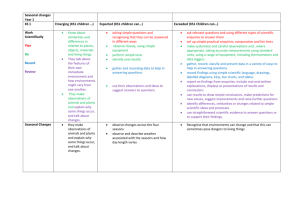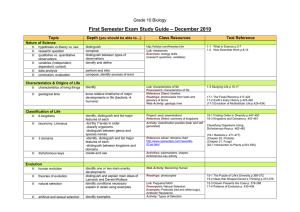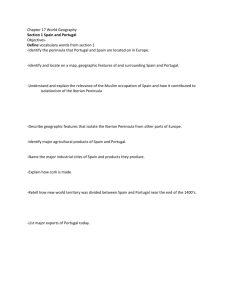Biology habitats expectation grid
advertisement
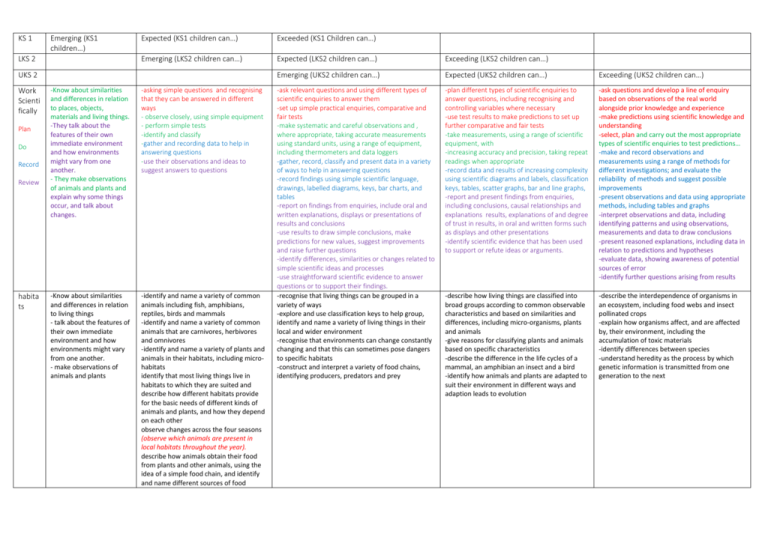
KS 1 Emerging (KS1 children…) LKS 2 Expected (KS1 children can…) Exceeded (KS1 Children can…) Emerging (LKS2 children can…) Expected (LKS2 children can…) Exceeding (LKS2 children can…) Emerging (UKS2 children can…) Expected (UKS2 children can…) Exceeding (UKS2 children can…) -ask relevant questions and using different types of scientific enquiries to answer them -set up simple practical enquiries, comparative and fair tests -make systematic and careful observations and , where appropriate, taking accurate measurements using standard units, using a range of equipment, including thermometers and data loggers -gather, record, classify and present data in a variety of ways to help in answering questions -record findings using simple scientific language, drawings, labelled diagrams, keys, bar charts, and tables -report on findings from enquiries, include oral and written explanations, displays or presentations of results and conclusions -use results to draw simple conclusions, make predictions for new values, suggest improvements and raise further questions -identify differences, similarities or changes related to simple scientific ideas and processes -use straightforward scientific evidence to answer questions or to support their findings. -recognise that living things can be grouped in a variety of ways -explore and use classification keys to help group, identify and name a variety of living things in their local and wider environment -recognise that environments can change constantly changing and that this can sometimes pose dangers to specific habitats -construct and interpret a variety of food chains, identifying producers, predators and prey -plan different types of scientific enquiries to answer questions, including recognising and controlling variables where necessary -use test results to make predictions to set up further comparative and fair tests -take measurements, using a range of scientific equipment, with -increasing accuracy and precision, taking repeat readings when appropriate -record data and results of increasing complexity using scientific diagrams and labels, classification keys, tables, scatter graphs, bar and line graphs, -report and present findings from enquiries, including conclusions, causal relationships and explanations results, explanations of and degree of trust in results, in oral and written forms such as displays and other presentations -identify scientific evidence that has been used to support or refute ideas or arguments. -ask questions and develop a line of enquiry based on observations of the real world alongside prior knowledge and experience -make predictions using scientific knowledge and understanding -select, plan and carry out the most appropriate types of scientific enquiries to test predictions… -make and record observations and measurements using a range of methods for different investigations; and evaluate the reliability of methods and suggest possible improvements -present observations and data using appropriate methods, including tables and graphs -interpret observations and data, including identifying patterns and using observations, measurements and data to draw conclusions -present reasoned explanations, including data in relation to predictions and hypotheses -evaluate data, showing awareness of potential sources of error -identify further questions arising from results -describe how living things are classified into broad groups according to common observable characteristics and based on similarities and differences, including micro-organisms, plants and animals -give reasons for classifying plants and animals based on specific characteristics -describe the difference in the life cycles of a mammal, an amphibian an insect and a bird -identify how animals and plants are adapted to suit their environment in different ways and adaption leads to evolution -describe the interdependence of organisms in an ecosystem, including food webs and insect pollinated crops -explain how organisms affect, and are affected by, their environment, including the accumulation of toxic materials -identify differences between species -understand heredity as the process by which genetic information is transmitted from one generation to the next UKS 2 Work Scienti fically Plan Do Record Review habita ts -Know about similarities and differences in relation to places, objects, materials and living things. -They talk about the features of their own immediate environment and how environments might vary from one another. - They make observations of animals and plants and explain why some things occur, and talk about changes. -asking simple questions and recognising that they can be answered in different ways - observe closely, using simple equipment - perform simple tests -identify and classify -gather and recording data to help in answering questions -use their observations and ideas to suggest answers to questions -Know about similarities and differences in relation to living things - talk about the features of their own immediate environment and how environments might vary from one another. - make observations of animals and plants -identify and name a variety of common animals including fish, amphibians, reptiles, birds and mammals -identify and name a variety of common animals that are carnivores, herbivores and omnivores -identify and name a variety of plants and animals in their habitats, including microhabitats identify that most living things live in habitats to which they are suited and describe how different habitats provide for the basic needs of different kinds of animals and plants, and how they depend on each other observe changes across the four seasons (observe which animals are present in local habitats throughout the year). describe how animals obtain their food from plants and other animals, using the idea of a simple food chain, and identify and name different sources of food

